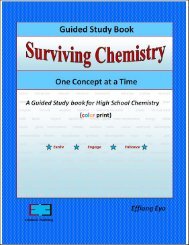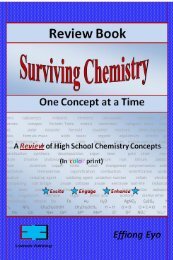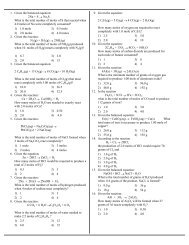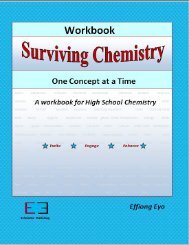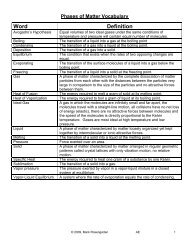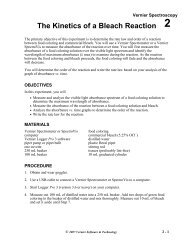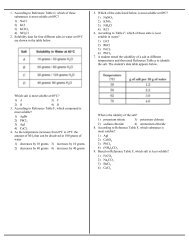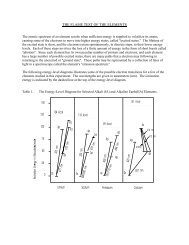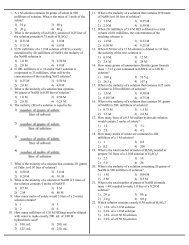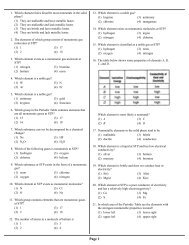Kinetics, Thermodynamics and Equilibrium - Revsworld
Kinetics, Thermodynamics and Equilibrium - Revsworld
Kinetics, Thermodynamics and Equilibrium - Revsworld
You also want an ePaper? Increase the reach of your titles
YUMPU automatically turns print PDFs into web optimized ePapers that Google loves.
1) <strong>Kinetics</strong> (HW: p. 23)<br />
Objective: You will describe a reaction in terms of mechanism <strong>and</strong> predict the effect of changing the mechanism or<br />
the number of effective collisions on the rate of a chemical reaction..<br />
How Reactions Happen<br />
Chemical kinetics - the study of reaction mechanisms <strong>and</strong> rates (how reactions occur, <strong>and</strong> how long they take)<br />
Mechanism - the "pathway" the reaction takes - a series of steps that leads from product to reactant.<br />
a) Particles of reactant must collide in order to react<br />
b) These collisions must occur with enough energy (activation energy) to react<br />
c) The molecules must be oriented properly to react.<br />
d) Collisions that satisfy both requirements that lead to the commencement of the reaction are<br />
called effective collisions.<br />
The mechanism can occur in a series of steps, each involving electron shifts as old bonds are broken <strong>and</strong> new bonds<br />
are formed.<br />
For the imaginary reaction 2 A + B --> A 2 B, a possible mechanism might be<br />
STEP 1: A + B --> AB (one of the two molecules of A reacts with the one molecule of B to form an intermediate<br />
molecule, AB)<br />
STEP 2: A + AB --> C (the remaining molecule of A reacts with the intermediate molecule AB to form the final<br />
product, C)<br />
NET: 2 A + B --> C (when considering the net equation, AB is found on both sides, <strong>and</strong> therefore cancels out)<br />
For the reaction H 2 + I 2 2 HI:<br />
STEP 1: H 2 2 H (the bonds between the hydrogen atoms must break by absorbing energy)<br />
STEP 2: I 2 2 I (the bonds between the iodine atoms must break by absorbing energy)<br />
STEP 3: 2 I + 2 H 2 HI (H would rather bond to I than to itself, so the atoms rearrange for this to happen. New<br />
bonds form, which releases energy)<br />
NET: H 2 + I 2 2 HI (2 H <strong>and</strong> 2 I are formed in steps 1 <strong>and</strong> 2, then used up in step 3. 2 H <strong>and</strong> 2 I are the<br />
intermediates, also known as the activated complex)<br />
Mechanism is like taking different roads to the same place. Depending on which road you take, it takes a different<br />
amount of time to reach your destination. The only way to know what the mechanism really is would be to do an<br />
experiment.<br />
Rate-determining step: the slowest step dictates the overall speed of the reaction. If there are eleven steps, ten of<br />
which are very fast, the other step, the slow one, determines the rate of the reaction.<br />
© 2009, Mark Rosengarten AE 2



